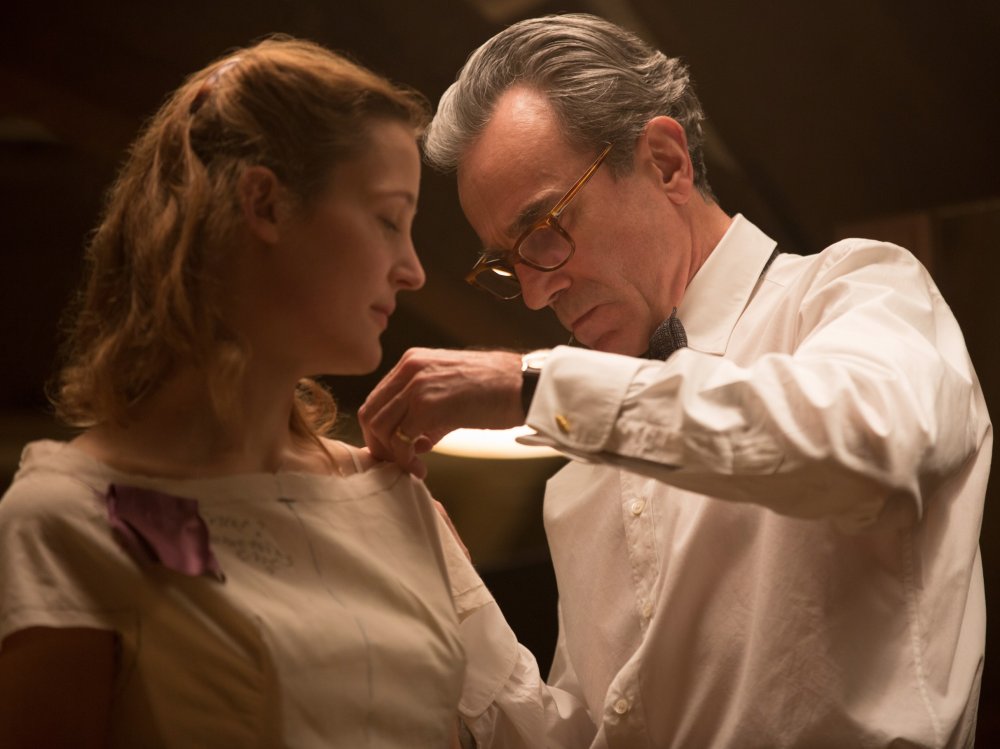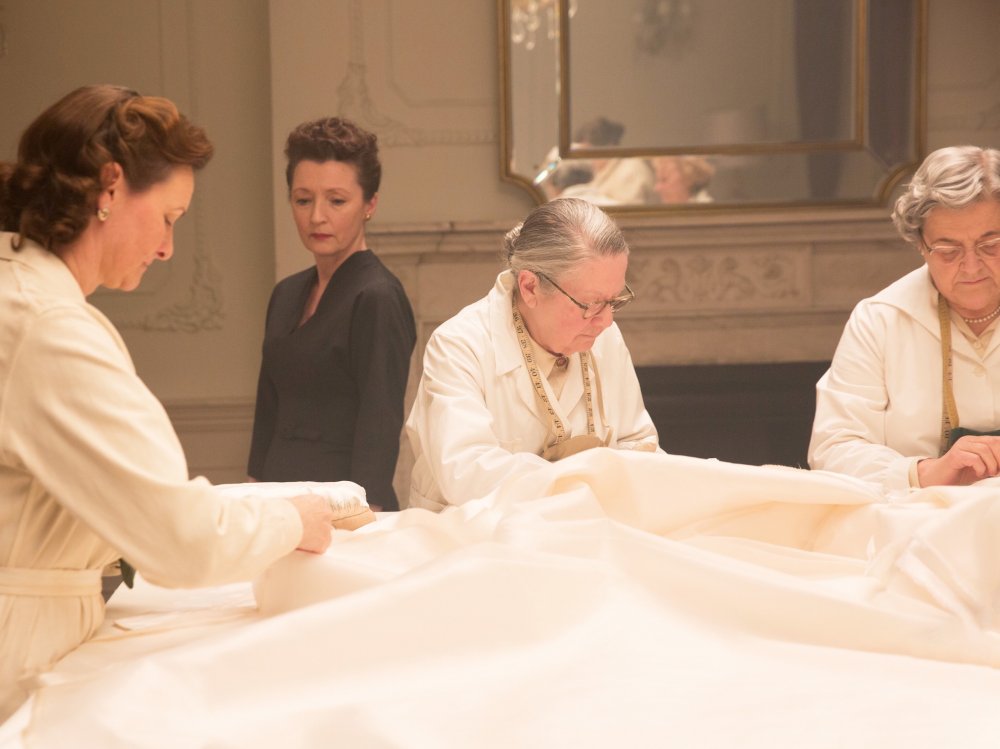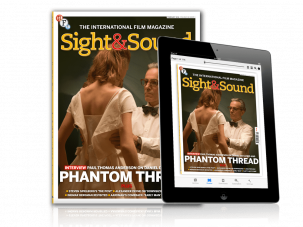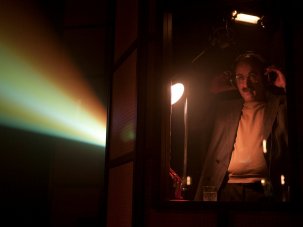The scrape of butter knife on toast. The swish of satin against silk. The creak of old floorboards. The slam of an angry door. The clip-clop-clip-clop of an impatient woman scurrying up stairs. The silences – the varieties of them, short and full, long and empty.
Paul Thomas Anderson’s 1950s-set melodrama Phantom Thread sounds so rich. The film about strident couturier Reynolds Woodcock (Daniel Day-Lewis) struggling both to do his work and love his mysterious new girlfriend (Vicky Krieps) is full of lavish noises that don’t just build tension: they are the tension. They help us inhabit Woodcock’s impatience, put us under the same delighted spell as Alma.
The dings, swishes, scrapes, bangs, thuds, crunches, clips and clops were designed by Christopher Scarabosio, a sound department maestro who has made noise as editor and designer for more than 100 films, including Star War Episode VII: The Force Awakens, The Mummy, Captain America: The Winter Soldier and Moonrise Kingdom. Scarabosio has worked with Anderson since Punch-drunk Love (and was Oscar-nominated for There Will Be Blood).

Phantom Thread (2017)
The goal for Anderson’s eighth feature was to produce noises that blended into Woodcock’s brittle world but still unsettled the audience. “We played with the idea that Woodcock’s house is a character unto itself, so we developed this language of creaks and pops,” Scarabosio told online magazine The Credits. “It’s not quite a haunted house, but we wanted to put you on edge and make you feel uneasy.”
In the ASMR community, Phantom Thread’s sounds have had the opposite effect than their intended irritation. Comments on ASMR Reddit threads and in Facebook groups have hailed the film’s noises as “a treasure trove of triggers”, “gourmet ASMR” and even “the best part of the film”.
ASMR stands for Autonomous Sensory Meridian Responses and ASMRers are people who experience a ‘low-grade euphoria’ when they encounter specific acoustic and visual stimuli. YouTube is glut-full of ASMR practitioners, making looped videos of pleasurable sounds, of elaborate role plays, of gift-box openings and book stroking, of deliberately slow makeup tutorials and up-close cucumber chewing. Videos as short as ten minutes and as long as ten hours aim to trigger viewers into a vague sensation of gentle elation or ‘tingles’, as the ASMR feeling is commonly referred to.

Phantom Thread (2017)
Lynn Cinnamon is an ASMR artist whose videos of tapping, crinkling, unboxing and soothing product reviews have racked up over a million YouTube views. She tells me simply: “ASMR is the opposite of jump scares.”
Phantom Thread has been noted by fans of ASMR (commonly referred to as ‘tingleheads’) because so much of its action falls into common ASMR categories:
- Whisper triggers. Woodcock speaks in a similar slow deliberate register that many ASMR artists affect in their video narrations.
- Personal care sounds. The thwack of Woodcock brushing his hair, the snip-snip-snip of him clipping at his nose and ears.
- Personal attention triggers. In ASMR these are demonstrated through role plays, as artists put up backdrops, put on uniforms and do their best to convince the viewer they are here to take care of them as a doctor, makeup artist, hotel receptionist etc. In Phantom Thread first Woodcock takes Alma’s measurements, busies himself around her body, his manner gentle, voice soft, hands so steady, you almost don’t notice that he is being brusque (“You have no breasts”). When it’s Alma’s turn to take care of him, she leers over his sick bed, and the sounds are of his breathing and her determined doting.
- Assorted acoustic triggers. The sounds that most commonly affect ASMRers, non-vocal ambient noises that are part of everyday living. For so much of the film Jonny Greenwood’s swooning score is besides the point. The sounds of feet on steps, spoon on teeth, fabric tearing, tea poured into cup, a body falling to the ground, ring out singularly, not under the music nor as a compliment to it. Clop. Clang. Rip. Drip. Thud. All on their own.
Cinnamon hasn’t yet seen Phantom Thread but isn’t surprised that a major motion picture could elicit such a positive response from tingleheads. Though sound is the key component to ASMR, it has predominantly taken off as a visual medium. “ASMR is extremely cinematic,” she told me. “There are so many role plays on YouTube that do next-level stuff when it comes to sound and range from informal to large productions with intricate storylines and atmosphere.”
As an example Cinnamon showed me the work of Ephemeral Rift, an ASMR artist who performs a wide range of characters including real people (the Pope) and those that belong in their own fictional worlds (Innsmouth monster, Batman, Groot). But most impressive is the ASMR universe he has invented peppered with oddball doctors, their wives, children and monsters. They pop up in a separate videos with ever more bizarre and sometimes sinister ways of provoking tingles. The characters are singular, well-written and performed so clearly with such attention to detail (latex masks, precise costuming) that the whole thing feels very cinematic.
Plain, non-role-playing ASMR can also feel filmic. ASMR Magic’s tapping, scratching and rubbing videos are shot statically, mostly no faces just hands. Filmed with such clarity and with sharp cinematography, they look like cinema.
Then there are ASMR artists such as Angelica whose work make the viewer feel as if they are at the movies because they use a lot of filmic tropes. Noir pieces, they’re shot in black and white, powered by whispers low and fast like a Raymond Chandler heroine, a cigarette burning in the corner of the screen. In one she’s a 1940s FBI agent; in others she’s Lolita, or Harry Potter, or Harvey Quinn.
What is likely to be the world’s first ASMR feature film was released on YouTube this year, produced and directed by UK based ASMR artist Mike Reed. 3AMASMR is a highly colour-saturated, Wizard of Oz-inspired tale that follows Dorothy-figure Eris as she searches for her missing boyfriend. On her meandering journey she befriends a homeless man, Crow, a broken android and a cowardly arms dealer. Background sounds are priotitised throughout – the rush off passing traffic, the rustling of carrier bags, the crinkly opening of a packet of pavlovas, then the invasive crunch as they are chewed loudly, the persistent clomp of footsteps as the characters trek down the street. All these sounds heard more clearly and cleanly than any of the film’s dialogue.
Last year directors Valerie Faris and Johnathan Dayton’s snuck ASMR into mainstream cinema. In Battle of the Sexes, their film that restages the events surrounding the 1973 tennis grudge match between Billie Jean King and Bobby Riggs, they shot an intentional ASMR scene – a fictionalised account of King (Emma Stone) meeting Marilyn Barnett (Andrea Risebourough), the woman who would become her secret lover.
The women meet at a beauty parlour, where Barnett, a hairdresser, cuts King’s hair. The music is soft. King comments on Barnett’s perfume, Barnett says she puts it on to help customers “relax” – as if this is the cue for the audience to do just that. A special close-up lens was used, the camera is tight on the women’s expressions, the whole world just their faces. The text is seduction, the subtext is of recognition, two woman, unguarded, seeing something in each other for the first time, they observe one another by looking in the mirror. Everything slows down, the scissors snip, the hairdryer hums, the rest of the world recedes.
Dayton told Fast Company: “People work to make videos that elicit this [ASMR] response, and we were wondering, ‘Could we get that response in a theatre full of people?’”
Cinnamon believes ASMR could have a future at the cinema if only there was a way to make the delivery of it more intimate. “You’d need extras tailored to the particular film. It would definitely be a premium experience. Maybe you could BYOB – bring your own blanket. They’d probably have to come and wake up most of the audience after the show.”
So much of the magic of cinema, of why certain films become our favourites, has to do with a very personal way they make us feel good. Because who can say exactly why the chimes at the beginning of Hysterical Blindness, the out-of-focus frames before we meet Debby and Beth, make me woozy? Or why Woody being fixed carefully in Toy Story 2, the toymaker clanking his toolbox open (“You can’t rush art,” he demurs), makes my brain so soft? Carol and Therese out to lunch for the first time, low voices, in love already but coy with one another, in Carol?
The hubbub of the air traffic control room in that languorous scene in Close Encounters of the Third Kind that makes me want to float? The sound of waves and the boat coming in as we wait for Ousmane Sembène’s Black Girl to arrive? The guests’ heavy footed toing and fro-ing in The Exterminating Angel? The Sheriff’s speech that you’ve got to lean into the screen to hear at the end of No Country for Old Men? All the snipping in Edward Scissorhands? The calligraphy scene in Crouching Tiger, Hidden Dragon? Melanie Griffith’s voice in Working Girl? All that natural sunlight and the sound of footsteps on the freshly polished hardwood floor in Housesitter? I could go on and on. And if you love films, so could you.
An indefinable quality is an essential part of the enjoyment of films. A feeling, a sensation that you can’t explain. A something that makes you happy, calm even, and that is why you return time and time again to the front row, why you can never be done watching movies. Who knows where they’ll take you next? Beyond narrative, beyond representation, beyond time or anything you can hold in your hands how they’ll make you feel, inside of yourself and outside too. ASMR has perhaps given us the beginnings of a language for this pleasure, if not yet a full understanding of it.
—
Correction (8 March 2018): an earlier version of this feature claimed that sound designer Christopher Scarabosio was Oscar-nominated for Phantom Thread. He wasn’t.
-
The Digital Edition and Archive quick link
Log in here to your digital edition and archive subscription, take a look at the packages on offer and buy a subscription.











